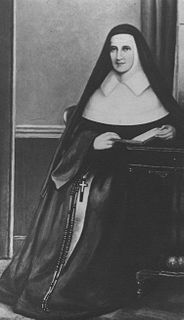
The Sisters of Mercy is a religious institute of Catholic women founded in 1831 in Dublin, Ireland, by Catherine McAuley. As of 2019, the institute had about 6200 sisters worldwide, organized into a number of independent congregations. They also started many education and health care facilities around the world.

Many religious communities have the term Sisters of Charity in their name. Some Sisters of Charity communities refer to the Vincentian tradition, or in America to the tradition of Saint Elizabeth Ann Seton, but others are unrelated. The rule of Vincent de Paul for the Daughters of Charity has been adopted and adapted by at least sixty founders of religious institutes for sisters around the world.

The Nativity of the Blessed Virgin Mary, the Nativity of Mary, the Marymas or the Birth of the Virgin Mary, refers to a Christian feast day celebrating the birth of Mary, mother of Jesus.
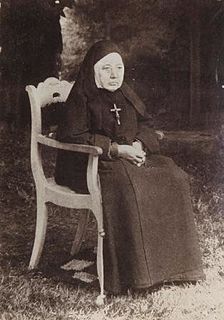
The Felician Sisters, officially known as the Congregation of Sisters of St. Felix of Cantalice Third Order Regular of St. Francis of Assisi (CSSF), is a religious institute of pontifical right whose members profess public vows of chastity, poverty, and obedience and follow the evangelical way of life in common. This active-contemplative religious institute was founded in Warsaw, Poland, in 1855, by Sophia Truszkowska, and named for a shrine of St. Felix, a 16th-century Capuchin saint especially devoted to children.

The Miraculous Medal, also known as the Medal of Our Lady of Graces, is a devotional medal, the design of which was originated by Saint Catherine Labouré following her apparitions of the Blessed Virgin Mary in Rue du Bac, Paris, France. It was made by goldsmith Adrien Vachette.

The Society of Mary, commonly known as the Marist Fathers, is a men's Roman Catholic clerical religious congregation of pontifical right. It was founded by Jean-Claude Colin and a group of seminarians in Lyon, France, in 1816. The society's name is derived from the Virgin Mary, whom the members attempt to imitate in their spirituality and daily work. Its members add the nominal letters S.M. after their names to indicate their membership in the congregation.

The Congregation of the Religious of the Virgin Mary is a Roman Catholic ecclesiastical community of pontifical right founded in Manila in 1684 by the Filipina Venerable Mother Ignacia del Espíritu Santo.
The Third Order of Saint Francis is a third order in the Franciscan order. The preaching of Francis of Assisi, as well as his example, exercised such an attraction on people that many married men and women wanted to join the First Order (friars) or the Second Order (nuns), but this being incompatible with their state of life, Francis found a middle way and in 1221 gave them a rule according to the Franciscan charism. Those following this rule became members of the Franciscan Third Order, sometimes called tertiaries. It includes religious congregations of men and women, known as Third Order Regulars; and fraternities of men and women, Third Order Seculars. The latter do not wear a religious habit, take vows, or live in community. However, they do gather together in community on a regular basis. "They make profession to live out the Gospel life and commit themselves to that living out the Gospel according to the example of Francis."
The Franciscan Missionary Sisters of the Immaculate Heart of Mary were founded by Blessed Mary Catherine Troiani, O.S.F., in 1868 in Cairo, Egypt. They are now established in fifteen countries. Their "...work includes service in clinics, hospitals, orphanages and the education of girls and young people.”
The Little Company of Mary is a Roman Catholic religious institute of women dedicated to caring for the suffering, the sick and the dying. The order was founded in 1877 in Nottingham, England by Venerable Mary Potter.

Bartolomea Capitanio was an Italian Roman Catholic professed religious and the co-foundress of the Sisters of Charity of Lovere that she established with Vincenza Gerosa. Capitanio's rather short life was dedicated to the educational needs of children and the poor and she served as a teacher for most of her life while using her order to achieve this aim.

Vincenza Gerosa - born Caterina Gerosa - was an Italian Roman Catholic professed religious and the co-foundress of the Sisters of Charity of Lovere that she founded alongside Bartolomea Capitanio. Gerosa met Capitanio in 1824 and the two consecrated themselves to God in the name of educating children and tending to the poor of the Bergamo area.
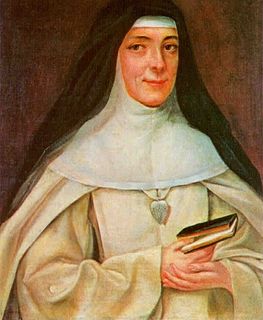
Mary Euphrasia Pelletier, born Rose Virginie Pelletier, was a French Roman Catholic nun, best known as the foundress of the Congregation of Our Lady of Charity of the Good Shepherd.
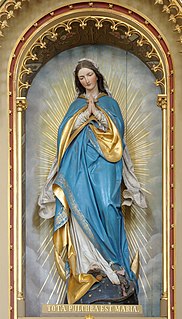
The Missionaries of the Company of Mary is a missionary religious congregation within the Catholic Church. The community was founded by Saint Louis de Montfort in 1705 with the recruitment of his first missionary disciple, Mathurin Rangeard. The congregation is made up of priests and brothers who serve both in the native lands and in other countries. The Montfortian Family comprises three groups: the Company of Mary, the Daughters of Wisdom and the Brothers of Saint Gabriel.
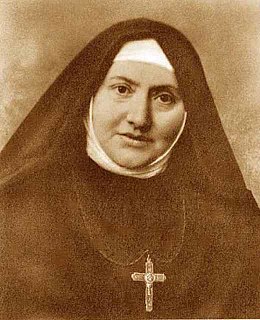
Geltrude Caterina Comensoli, also known as Mother Geltrude is the Patron of Youth, Val Camonica and Relic Custodians. She was the founder of the Institute of the Sacramentine Sisters.

In the history of the Catholic Church, women have played a variety of roles and the church has affected societal attitudes to women worldwide in significant ways. Influential Catholic women have included theologians, abbesses, monarchs, missionaries, mystics, martyrs, scientists, nurses, hospital administrators, educationalists, religious sisters, Doctors of the Church, and canonised saints. Women constitute the majority of members of consecrated life in the Catholic Church: in 2010, there were around 721,935 professed women religious. Motherhood and family are given an exalted status in Catholicism, with The Blessed Virgin Mary holding a special place of veneration.

Pierina Gilli, was a Roman Catholic Italian who claimed to receive messages from the Virgin Mary in 1947 and 1966. The apparitions were determined by the local ordinary, after consultation with the CDF, to be lacking in sufficient evidence of credibility.
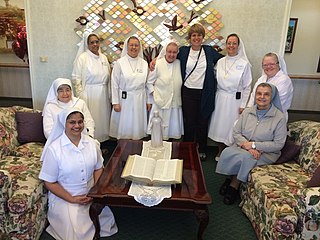
The Franciscan Hospitaller Sisters of the Immaculate Conception are members of a Roman Catholic religious institute of consecrated women, which was founded in Portugal in 1871. They follow the Rule of the Third Order Regular of St. Francis. and, as the term “hospitaller” indicates, focus their ministries on a spirit of medical care. Their charism emphasizes hospitality and service under the model of the Good Samaritan. In this congregation, the postnominal initials used after each Sister's name is "F.H.I.C."
Leonarda Angela Casiraghi, popularly known as Doddamma, was an Italian-born naturalised Indian Catholic missionary and social worker, known for her medical service in Dharwad, in the south Indian state of Karnataka. She founded a small medical dispensary in Dharwad in 1958, which later grew to become a full-fledged hospital by name, Our Lady of Lourdes Charitable Hospital. She came to India in 1955 and worked in Mangalore and Hyderabad for three years before founding the medical facility in Dharwad. A member of the Sisters of Charity of Saints Bartolomea Capitanio and Vincenza Gerosa congregation, she was the administrator of the hospital and its sister concern, Our Lady of Lourdes School of Nursing, since their inception. She was awarded the fourth highest civilian award of the Padma Shri by the Government of India, in 1998, for her services to the society
Bishop Mathias Sebastião Francisco Fernandes was a Roman Catholic bishop, the first native to be bishop of Diocese of Mysore in Mysore, India. His tenure was marked by the introduction of a number of religious orders offering educational opportunities within the diocese. He was of Goan origin.

















